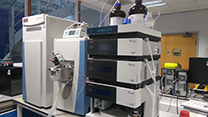Infastructure in the AMHT Division
More expertise and equipment in the Division of Advanced Materials and Healthcare Technologies
SCIEX 4000 QTRAP LC-MS/MS
This instrument combines triple quadrupole scan modes with sensitive ion trap scans (MS3) in a single LC-MS/MS run. The QTRAP 4000 offers electrospray and APCI ionization modes. A nanospray source is also available. This ion trap mass spectrometer is interfaced with an automated Shimadzu LC-HT series HPLC and a UV detector. Advanced MS scanning options and information dependent acquisition offer unique approaches to metabolite profiling and identification. This instrument offers excellent sensitivity for both quantitative and qualitative targeted metabolite profiling, and for the identification and structural confirmation of new metabolites. Further information is available from Applied Biosystems.
High performance liquid chromatography(HPLC)
The laboratory is equipped with a further three stand-alone, automated HPLC systems with full software control and a range of detectors including fluorescence, diode array UV and evaporative light scattering. These systems are used either for biological analysis or for LC-MS method development. Models include Agilent 1100, 1050.
Advion TriVersa nanomate chip-based infusion and LESA-MS
The Triversa Nanomate from Advion offers greater flexibility to both LTQ Velos and Exactive operations. As a chip-based, nanospray interface, mass spectrometer sensitivity is enhanced while eliminating sample cross contamination. The system may be used in direct infusion mode, in direct liquid extraction of sample surfaces (LESA) or in nano-LC modes. Using direct infusion mode, a high through-put analysis may be very rapidly be performed. The contents of a 96-well microtitre plate can be completed within the hour. LESA offers the possibility of performing mass spectrometry experiments from solid samples presented in the form of, for example, dried spot, membrane or tissue slices. When using the Nanomate as an LC interface, the flow from a conventional LC system is split, with low flow being diverted to the disposable chip interface.
Waters Quattro Ultima LC-MS/MS
This is a workhorse triple quadrupole instrument with excellent performance for quantitative analysis. It is used for targeted metabolite profiling and readily capable of monitoring multiple analytes simultaneously. It offers both electrospray and APCI ionisation modes and is coupled to an Agilent 1100 series HPLC with UV diode array detection. Current projects include analysis of eicosanoids, endocannabinoids from mammalian tissues and flavonoids in fruit extracts.
Thermo Scientific Exactive high resolution MS with UHPLC
Offering high resolution both chromatographically and up to 100,000FWHM
mass spectrometry, this system is ideal for single stage analysis of
complex biological samples. Using Orbitrap (Orbital ion trap)
technology, accurate mass to 3ppm or less is readily achieved to assist
identification. The high full scan sensitivity is used for comparative
metabolomic global profiling where the maximum amount of information is
required from a sample. Further software packages (MetID, ToxID,Seive
and Progenesis QI) provide metabolomics data outputs suitable for
pattern recognition software such as SIMCA-P (Umetrics) and direct
access to database search engines. The Omnispray sources are both
compatible with the Exactive mass spectrometer. Quantitative analyses
can be developed where appropriate standards are used
Prosolia DESI for MS-imaging
DESI is a combination of electrospray (ESI) and desorption (DI) ionization methods applied to a surface. A fine aerosol is generated by a jet of nitrogen around a microlitre/min flow of solvent mixture. The charged electrospray mist is applied at close range (mm) to the surface. After ion desorption from the surface, the ions travel at atmospheric pressure to the mass spectrometer interface which is an adapted transfer capillary. The Omnispray 1D and 2D (Prosolia) sample stage control can be automated for fine control in either 1 or 2 dimensions. Further software can used to create maps locating the source of ions detected. These interfaces are used in as inlets for either the Exactive or Velos MS systems.
Thermo Scientific LTQ Velos ion trap MS with UHPLC
The LTQ Velos is a dual cell linear ion trap mass spectrometer offering nominal mass MSn for quantitative analysis or structural elucidation. Although infusion studies can be useful, analyses can be automated using a cooled autosampler. The high resolution Accela LC front end enables analysis of complex biological samples. Advanced scan options enable screening for metabolite by monitoring common mass spectral features. Further software packages (eg MetID) can provide information of metabolic transformations. Both the Velos and Exactive have available high and low flow rate electrospray and APCI sources. The Omnispray sources are both compatible with the Exactive mass spectrometer.
Thermo Scientific MSQ LC-MS
This system is a single Quadrupole LC-MS system, with a Thermo MSQ Plus and a Thermo Ultimate 3000 HPLC system (incl a diode array UV detector, twin peltier, 120 place temp controlled autosampler and quaternary pump) Thermo Dionex Chromeleon. It can be used as a stand-alone uHPLC-UV system or as LC/MS, nominal mass only.
Thermo Scientific Q-Exactive Plus high resolution MS with UHPLC
Offering high resolution both chromatographically and up to 140,000FWHM mass spectrometry, this system is ideal for single stage analysis of complex biological samples but also offers quadrupole selection for structural confirmation. Using Orbitrap (Orbital ion trap) technology, accurate mass to 3ppm or less is readily achieved to assist identification. The high full scan sensitivity is used for comparative metabolomic global profiling where the maximum detailed information is required from a sample. Further software packages (LipidSearch, CompoundDiscoverer, MetID, ToxID, Seive and Progenesis QI) provide metabolomics data outputs suitable for pattern recognition software such as SIMCA-P (Umetrics) and direct access to database search engines. Quantitative analyses can be developed where appropriate standards are used, identity confirmed by sophisticated scan functions. Samples can be introduced using the uHPLC U30000 system.
